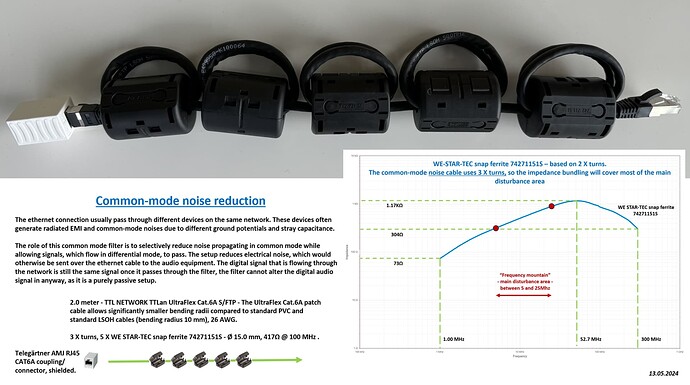At the risk of veering OT (temporarily), please let us know which switch you’re referring to…
I prefer to avoid bringing any trade interest to this lovely forum, but I think this might be where I declare an OT interest as I make audio-optimised network switches. Might be worth starting a new thread on switches, as I’m more comfortable contributing on a purely cable thread here. ![]()
Understood, Nigel.
No doubt, the subject of switches warrants (another) new thread…
but my quick (OT) question was actually for @Lee …![]()
Understood. I’ll just sit here and bite my lip while you talk about switches then and I definitely won’t join in. ![]()
I don’t think you meant “aggressively”; you meant “confidently”. ![]()
Ansuz PowerSwitch D2
![]()
(Actually, IMHO, the more appropriate word is “opportunistically”)
I agree with @Anupc.
According to dCS, there are two key words to look for with respect to ethernet cables: “unshielded” and “passed certification.”
The ethernet cables below fit that description, and enable many users of this forum to channel more $ instead into the DAC, clock, amp, speakers, etc.
BJC: “The vast majority of cables sold as Category 6 or 6a, whether in brick-and-mortar establishments or online, simply do not meet the Category 6 or 6a specifications; we’ve put a lot of samples of a lot of other manufacturers’ product through proper certification testing, and cables that actually pass spec are unusual. In fact, it’s not uncommon for cables that are sold as “Cat 6” to even fail to meet Cat 5e specifications. Vendors get away with misrepresenting Ethernet patch cord performance because the average consumer isn’t in a position to buy the $10,000 worth of gear it’ll take to check his purchase against the spec. Here at Blue Jeans Cable we don’t want to have anything to do with misrepresenting spec compliance – every Ethernet patch cable we sell comes with its own individual test report, run on a Fluke DTX-1800 certification tester, showing that it meets or exceeds the applicable spec. If it doesn’t, we won’t sell it.”
Thanks.
Now, back OT to Ethernet cables…
Those with ears shall hear.
So I bought a Blue Jeans ethernet cable and it was horrible sounding. Measurements only describe part of the subjective sound quality in my experience.
Agreed. The subjective sound quality of an ethernet cable (which is asynchronously moving packets of data around) will be determined primarily by the amount of noise which accompanies the digital signal. This may or may not be measurable but it is usually quite clearly audible. No 0’s and 1’s are harmed or enhanced in the signal transportation process…
Sorry, there’s absolutely no noise on a piece of wire that a human can hear but an instrument can’t measure.
Modern electronics like Mobile phones or laptop computers would not be able to function if what you say is true. Even a cheap sub-$1,000 Oscilloscope can measure noise a 1,000 times better than human hearing.
“Horrible sounding” -
so I guess dCS is not to be trusted as they recommend any cable which is certified, tested and measured. Blue Jeans, Amazon Basic, etc. fit that definition.
I think some at dCS would say that certain ethernet cables sound better than others.
You clearly don’t understand digital for audio, @Anupc, as you keep referring to digital data. No-one claims that digital data gets corrupted. The frequency of the noise is irrelevant; it reaches the DAC where it manifests itself as intermodulation noise clearly audible across the frequency spectrum. It’s an analogue issue, quite clearly audible to anyone installing a decent switch just before their streamer.
It’s just plain silly of you to keep insisting that anyone who sells switches for audio and anyone who buys switches for audio is kidding themselves through an overactive imagination, psychoacoustics or whatever. The issue is real, the solution is real.
It is all about common-mode noise. No need to buy an expensive switch.
On the last mile - before streamer/DAC:
Torben
Let’s get very specific then shall we.
Please explain what exactly “reaches the DAC” thats immeasurable? And what signal is this “intermodulation noise thats audible”?
Let’s not name call shall we, otherwise it’s going to escalate and get the thread shutdown ![]()
It’s all been explained before, @Anupc. Repetition isn’t going help anyone. If you have yet to experience the issue and a solution yourself, that’s fine, but please don’t repeatedly assert that it’s a universal truth.
I was careful not to name call. “Silly” referred to what you said, not to you as a person. You’re a valued contributor here and have some fabulous experience and knowledge, but have been repeatedly dismissive of experiences different from yours and that is what I refer to as silly.
I hope the OP has his answers now.
Can’t remember if anybody has posted this but at risk of repetition my new favourite website tested ethernet cables and found that there were definitely differences in SQ. Interestingly their conclusion was that the connectors were irrelevant to SQ but the shielding was definitely a major factor. And contrary to a view popular here and elsewhere they found that shielding connected at both ends (even double shielding connected at both ends) sounded better.
